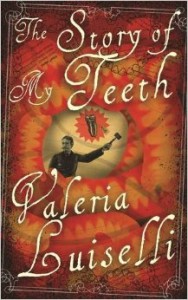Granta, $24.99
April 2015
Firstly, if clowns and questionable dentistry are not your thing I am just going to warn you that there is a scene in Valeria Luiselli’s The Story of My Teeth containing both creepy clowns and discussion of teeth and dentistry—enough so that you will be falling asleep with your mouth firmly closed and keeping one eye on all large projection screens in the near future. However, do not let that put you off entering the world of Gustavo ‘Highway’ Sánchez, main narrator of The Story of My Teeth and self-proclaimed best auctioneer in the world, who on the first page announces that he wishes to tell the story of his teeth. This tale is also Highway’s life story–and not just for the fact that teeth generally being in one’s mouth throughout one’s life imply that the teeth and the owner of the mouth have the same story.
Luiselli’s novel—translated from Spanish to English by Christina MacSweeney—is whimsical and full of wry humor that transforms the mundane steps of life into the almost magical. It is reminiscent to me of the writing of Isabel Allende and Jasper Fforde, whose styles take the reader’s commitment and rewards them with rich worlds of magical realism (the former) or fantasy (the latter).
The Story of My Teeth is not a straight textual narrative within the physical book. Instead the text is interspersed with headings, both between and within chapters; quotes; proverbs (whose text is set at 90 degree angles to the written narrative); images; and The Chronologic, a timeline of Highway’s life to round out the book. These changes in format serve to pull the reader in and out of different sections, creating an almost enforced reflectiveness on what has come before and what is to come after, which I quite enjoyed. It seems especially suited to those whose reading time is, more often than not, broken into small chunks by the demands of life.
When I was a much younger reader I would always avoid additions to the story proper. In part because I stubbornly wanted to figure everything out for myself, and in part because I just wanted to dive into the story, like, right now. Over time my attitude has shifted so that now I will read the extraneous sections of a text once I have finished the main text. So discovering that the English language version of The Story of My Teeth was the result of a multi-layered collaboration was a lovely surprise. The first layer of collaboration stems from this novel’s genesis as a commissioned piece of fiction, and its development as a serialised work, which went back and forth between the author and a reading group of factory workers in Ectapec, a suburb outside Mexico City.
The second layer of collaboration and evolution came as the work was translated from Spanish to English by MacSweeney. Luiselli made deliberate changes to the translated copy so that the English version is distinctly different to the Spanish version, and additionally includes The Chronologic, which was created by the translator. I was especially taken by the idea—and a little sad that I do not read Spanish—that the different language versions differ intentionally and in a greater degree than the small changes that are inherent in the process of translating works.
Despite enjoying the fantastical elements of this novel and learning of the collaborative nature of its creation, I do have one major issue with The Story of my Teeth, and this is the portrayal of women. There is not a single female character in this novel who is not described as a harridan or a harlot, except maybe Highway’s mother who is easily dismissed as being ‘trained to accept filth as her fate’. Additionally, there is an excruciatingly long passage in which Highway rates all the women he has been in relationships with on their sexual availability, both willingness and attractiveness when newly woken, for morning sex. It is clear that an element of this story is that the narrator, Highway, is consciously relating his story to the reader. And that the inclusion of a second narrator later in the text indicates that Highway’s narrative is unreliable, with both subconscious and deliberate edits in the telling of his tale. Thus the misogyny may be an intended element of Highway’s character, but it really detracted from my experience of this work.
In spite of my uncomfortableness with the portrayal of female characters in The Story of my Teeth, I found the collaborative nature of its creation incredibly interesting and I was genuinely engaged with the writing style and Highway’s story to keep reading until the end. So although I would recommend this particular title with caution I am quite curious to investigate further works from this author.


